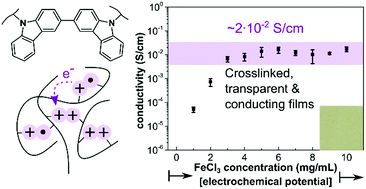Towards highly conducting bicarbazole redox polymer films with plateau-like conductivities†
Abstract
Chemical doping of redox polymer films based on triphenylamine (PVTPA), phenylcarbazole (PVPhCbz) and carbazole (PVCbz) pendant redox units is performed with different concentrations of FeCl3 solutions. Analogies to in situ electrochemical doping show that stable crosslinked dimer containing redox polymer films are created. The conductivity behavior of the doped films is analyzed and the charge carrier species are identified by UV-Vis-NIR spectroscopy. In particular the behavior of PVCbz upon doping is unique: transparent films with conductivities as high as 2 × 10−2 S cm−1 are found over a large range of FeCl3 concentrations. Such plateau-like conductivity – also encountered upon electrochemical doping – is a phenomenon, usually only found for conjugated polymers such as poly(3-hexylthiophene). PVTPA and PVPhCbz on the other hand show bell-shape behavior with maximum conductivities reaching 10−3 S cm−1 for a limited range of dopant concentrations. The stability (induced by crosslinking) and the transparency make the layers applicable as transparent electrodes or hole-transport layers in opto-electronic devices. The observed results are discussed in the context of mixed valence conductivity with high conductivities only accessible when a certain amount of dications coexists with radical cation species. While PVTPA and PVPhCbz follow the classical findings of the model, a favorable π-stacking tendency of bicarbazole dimers seems to strongly improve efficient communication between the redox sites in the three dimensionally connected redox polymer films. Our results indicate that the nature of charge propagation of redox and conjugated polymers is closer than usually discussed in the literature which can be mainly attributed to intermolecular interactions throughout the films. Last but not least we want to highlight the strength of in situ electrochemical techniques to identify charged species and potential-dependent conductivity regions which help targeting optimized chemical doping.

- This article is part of the themed collection: Celebrating Tobin Marks’ 75th Birthday


 Please wait while we load your content...
Please wait while we load your content...